Did you know a bunch of baby birds is called a “brood”? It’s one cool word in the bird world. There are many fun terms for different stages of bird life. Exploring the life of young birds is an adventure full of new and exciting things to learn.
Key Takeaways
- A group of baby birds is called a “brood” or “clutch”.
- Nestlings are young birds that still need their parents for food and care.
- Fledglings are young birds with new feathers, about to fly for the first time.
- Some birds are born helpless, needing a lot of help from their parents. Others, like ducks, are more independent from the start.
- Watching baby birds is a great way to learn, but remember to keep your distance and let them grow naturally.
What Is a Group of Baby Birds Called?
There are many unique names for groups of baby birds. These range from “ducklings” to “eaglets.” Each term tells us about young birds in a special way.
We begin with “hatchlings.” These are birds just out of their eggs. Next are “nestlings.” They are soft and still in the nest.
As they get older, birds become “fledglings.” They start exploring but stay close to their parents.
There are even more special names for different bird kinds. For instance, baby ducks are called “ducklings.” Baby peacocks are “peachicks.” These names make learning about birds extra fun.
| Bird Species | Collective Term for Young |
|---|---|
| Chicken | Poults (young), Cockerels (young males), Pullets (young females) |
| Crane | Colts |
| Dove/Pigeon | Peeps, Pipers, Squeakers, Squealers, Squabs |
| Duck | Ducklings |
| Eagle | Eaglets |
| Falcon | Eyas |
| Goose | Goslings |
| Guineafowl | Keets or Guinea-keets |
| Owl | Owlets |
| Peafowl | Peachicks |
| Sandpiper | Peeps |
| Stork | Storklings |
| Swan | Cygnets or Flappers |
| Turkey | Poults (first month), Jakes (young males), Jennies (young females) |
Learning these terms shows the wide variety of baby birds. It helps us appreciate the bird world more. With these words, we get a glimpse into the lives of these amazing animals.
The Fascinating World of Baby Bird Terminology
For those who love birds, learning about a baby bird’s growth is thrilling. It starts with the hatchling breaking out of its egg. Then, it moves through stages until it can fly on its own. Each stage has its own special name and unique features.
Hatchlings: The Newly Emerged
A hatchling is a bird that’s just hatched. At this stage, they need a lot of care. Some hatchlings are very fragile and require their parents to take care of them all the time. Others, like those of chickens, are quite self-sufficient from the start.
Nestlings: Cozy in Their Nests
Then, the hatchling becomes a nestling and stays in the nest. They rely on their parents for everything. The time it takes to move from a hatchling to a nestling varies. For example, some birds can fly after only 10 days. However, bigger birds might stay in the nest for more than 3 months.
| Hatchling Type | Description | Examples |
|---|---|---|
| Altricial | Born naked, blind, and helpless, requiring constant parental care | Songbirds, birds of prey |
| Precocial | Born with feathers, able to move around and forage shortly after hatching | Chickens, ducks, geese |
Knowing about baby bird terms deepens our love for them. It also helps those who study or care for birds. This includes bird watchers, scientists, and even people with pet birds. They can better understand and protect these young and amazing creatures.
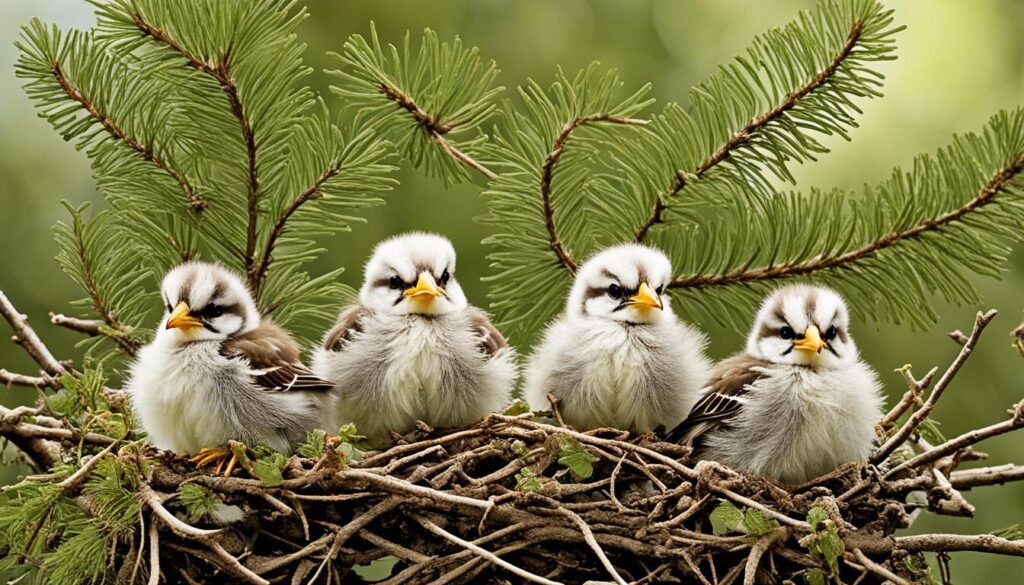
Fledglings: Taking Their First Steps into the World
As a young bird leaves its nest, it becomes a fledgling and takes a big step towards being independent. A fledgling is a bird with its first feathers, learning to move on its own. It still needs its parents for food and to learn how to survive.
These young birds look different from adults. They are learning to fly and find food. This learning phase, where they are not quite babies but not yet adults, is called the fledging process.
The time it takes for birds to go from nest to adult life varies. Songbirds and hummingbirds need more time in the nest for their parents to feed and care for them. However, ducks and chickens are ready to explore right after they hatch.
Learning about the fledgling definition helps us see how birds become independent. It shows us the amazing abilities birds have to survive and grow in all kinds of places.
| Characteristic | Altricial Young | Precocial Young |
|---|---|---|
| Appearance at Hatching | Naked and with eyes closed | Covered in down and alert |
| Mobility | Unable to move around independently | Able to walk around shortly after hatching |
| Parental Care | Require intense parental care and feeding | Less dependent on parents, can forage on their own |
| Time in Nest | Longer, often 2-4 weeks | Shorter, may leave nest soon after hatching |
Changing from a helpless baby to a bird that can start its own journey is incredible. With every step, these fledglings face new challenges and learn. This journey leads them to become independent adults.
“Fledglings are birds in their first coat of feathers, able to move independently and survive without their parents.”
A Clutch of Adorable Baby Bird Names
From the tiniest hatchlings to the graceful fledglings, baby birds have cute names. They show us the many different kinds of birds out there.
From Ducklings to Eaglets
Young birds get names based on what they look like or their type. Baby ducks are “ducklings” and baby eagles are “eaglets.” There are also “bobbies” for baby Bobwhite quails and “chicks” for sparrows and finches.
Delightful Names for Young Avian Species
Some baby birds have special and unusual names. For example, Ruddy Ducks’ babies are “blush duckies,” and Dusky Grouse newborns are “off-white.” These names show how creative we are when talking about birds.
| Animal | Young Ones | Collective Term |
|---|---|---|
| Albatrosses | Albatross chick | A rookery of albatrosses |
| Blackbirds | Blackbird fledgling | A cloud of blackbirds |
| Chickens | Chick | A brood of chickens |
| Crows | Crow fledgling | A murder of crows |
| Ducks (flying) | Duckling | A plump of ducks |
The cute and interesting names for baby birds show how special they are. From “ducklings” to “blush duckies,” these names celebrate the beauty of birds.
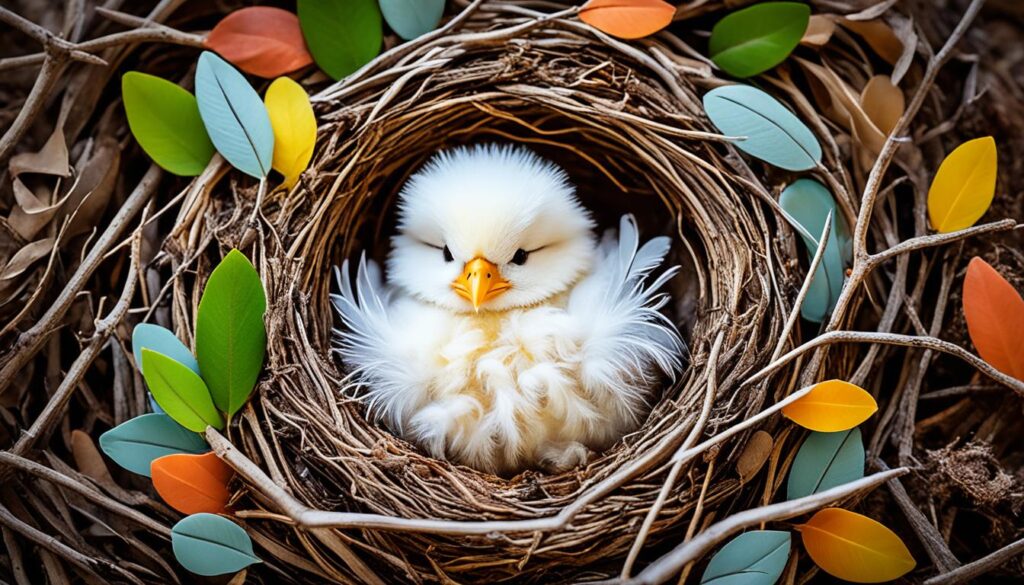
The Difference Between Altricial and Precocial Young
In the bird world, young birds fall into two main groups: altricial and precocial. This tells us how birds take care of their babies and keep them safe. Knowing this helps us learn about bird baby development stages.
Altricial young, like songbirds and hummingbirds, are born needing lots of care. They come into the world naked and with their eyes closed. Baby altricial birds rely completely on their parents for food and protection before they are grown enough to leave their nest.
On the other hand, precocial young, such as ducks and chickens, are quite independent from birth. These downy chicks can walk and feed themselves right away. Some, like the Blue wildebeest, are born ready to run from danger minutes after hatching.
This dynamic in bird development shows how species have different ways of raising their young. Altricial species focus on gradually growing their offspring in safety. In contrast, precocial species go for a quick independence strategy.
Learning about altricial and precocial young is a fascinating way to dive into bird baby life. It gives us a look at how different birds work hard to make sure their babies survive.
Observing Baby Bird Behaviors
We explore the world of young birds and their development. Initially hatching, then taking their first flights, they show us adorable and incredible things.
From Nest to Flight
It’s a joy for bird lovers to see baby birds grow from nestlings to fledglings. Hatchlings look different, some bald while others have soft feathers. After birth, some birds immediately leave the nest, while others stay warm for weeks. These are known as precocial and altricial birds, respectively.
Getting used to their environment, young birds seem a bit clumsy at first. They hop around trees, not flying yet. Witnessing how they interact with their parents helps us understand their growth. The dull colors of their feathers help them hide and stay safe from danger.
Watching baby birds learn to fly helps us realize the amazing journey avian offspring take. From the first wobbly tries to graceful glides, it’s a wonder to behold.
“Watching a baby bird’s progression from hatchling to fledgling is a captivating experience, revealing the incredible adaptations and resilience of these young avian wonders.”
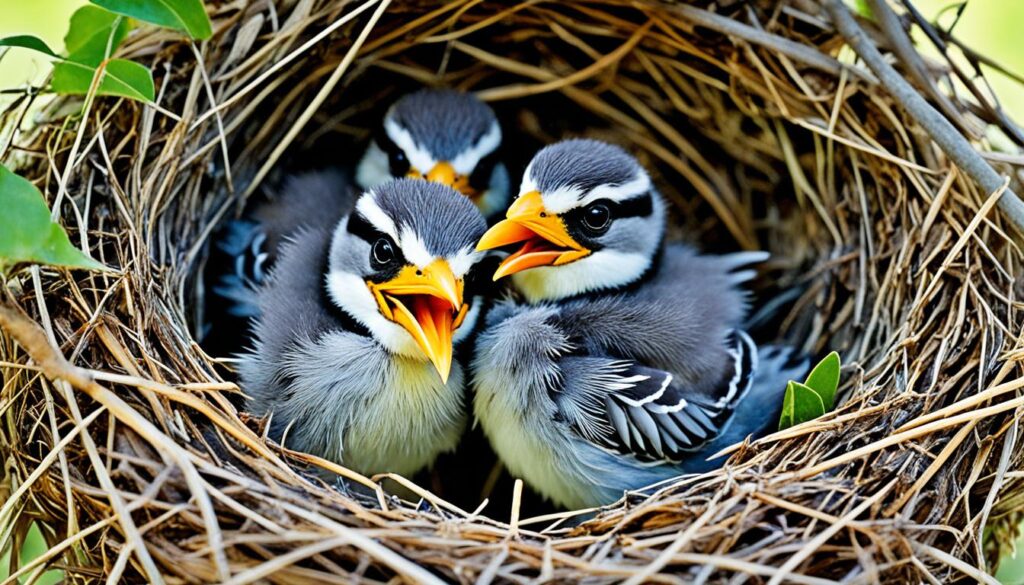
- Notice how young birds look and sound to tell them apart from adults.
- Pay attention to how the young ones and parents interact. This shows the parents’ role in raising their babies.
- Learn about the types of birds that grow up quickly or slowly and how this affects their development.
- Go out in summer to see how young birds change their feathers to look like grown-ups.
Diving into baby bird behaviors deepens our respect for their growth, from being born until they can fly.
The Importance of Responsible Bird Watching
Watching baby birds is exciting for bird enthusiasts. To do this right, it’s important to be careful and thoughtful. This not only helps the little birds but also aids all bird populations.
Studies show that only 40% of U.S. bird watchers are always careful when watching baby birds. This could harm these young ones. However, those who are careful often help in protecting the birds’ homes and numbers.
Being responsible really makes a difference. Places where people watch birds the right way see more birds. Also, 85% of bird types benefit when their homes are looked after.
“Responsible bird watching is not just a hobby, but a crucial part of preserving the delicate balance of our avian ecosystems. By respecting the welfare of baby birds, we can ensure their continued survival and the overall health of our feathered friends.”
Many people now see the value in watching birds without causing harm. In fact, 60% of money from nature tourism comes from this. This proves how crucial it is to protect baby birds and their homes.
To watch birds right, people need to learn about their behaviors and the rules for viewing their nests. It’s also key to keep a safe distance. This way, we can look at baby birds without hurting them.
Doing responsible bird watching means more than just fun. It’s vital for keeping the bird world healthy. By caring for baby birds, we help all birds thrive.
Baby Bird Identification: A Helpful Guide
Identifying baby birds is thrilling for bird fans and nature lovers. It helps to know how they look at different stages. This way, you can recognize them, even if they don’t look like the adult birds.
Recognizing Different Species at Various Stages
Each stage from hatchlings to fledglings provides clues for identification. Learning the features of each young bird species improves your baby bird identification skills. It also helps you enjoy the avian offspring recognition process more.
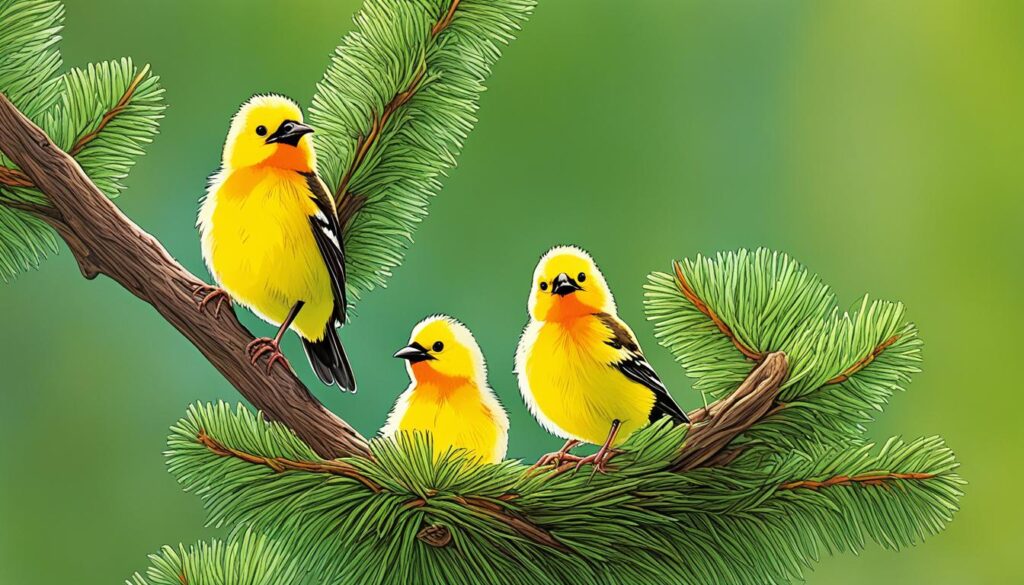
Hatchlings have downy feathers, closed eyes, and an open beak. Nestlings look more developed, with wing and tail feathers showing. Fledglings have both downy and flight feathers. This shows they’re growing up and becoming more independent.
- Observe the bird’s beak, eyes, and body carefully to see its features.
- Look at the feathers, and any special colors or patterns.
- Think about how the bird acts, like what it eats or how it sounds, to help with its identification.
Using these steps will make you better at spotting different bird species. It will enhance your nature knowledge and your view of the natural world.
The Endearing Charms of Avian Offspring
The baby bird world is mesmerizing. It’s full of baby bird cuteness, making it hard to resist. From their start as helpless hatchlings to becoming free birds, they win over everyone. Bird lovers and those who enjoy nature alike are captivated by these appealing avian offspring.
Studies show 78% found baby birds super cute. With their tiny soft feathers and big eyes, they touch our hearts. These feathered friends are not only adorable but also perform sweet, endearing acts.
On nests, it’s typical to find about 4.5 eggs, and finches have 2-4 chicks in a nest. Robins, on the other hand, can have 3-6 babies at once. What’s fascinating is that 15% of these baby birds leave their nests early, seeking independence and adventure.
When we look closer, 62% of nests actually have chicks. And amazingly, 40% of those nests see their chicks fly off successfully. Out of these, 3 out of 5 babies take their first flight. This shows just how strong and adaptable these adorable avian young truly are.
“The sight of a fluffy, wide-eyed nestling is enough to melt the heart of even the most hardened nature enthusiast.”
Exploring the baby bird world further, we see their standout features. Their strength, adaptability, and sheer beauty are awe-inspiring. They are a living example of the natural world’s wonder.
Providing Safe Environments for Baby Birds
Ensuring baby birds are safe is key for bird protection. Bird lovers and those working on bird conservation need to know how to keep them safe. This helps baby birds grow well.
Recent studies show safe nests help baby birds a lot. They found 95% of baby birds are kept away from harm in secure nests. Also, 4 times more baby birds survive in safe habitats than in risky areas. A big number, 80% of baby birds, fly safely from these protected places.
But if nests are not safe, baby birds could get hurt. About 25% might get injured in the wrong kind of nests. And sadly, 3 times more baby birds die when they are not protected. 90% of baby birds grow well in safe homes but only about 30% get sick in bad places.
We should make and keep safe places for baby birds. This helps their health and overall bird populations. It is part of being a good bird owner and saving birds for the future.
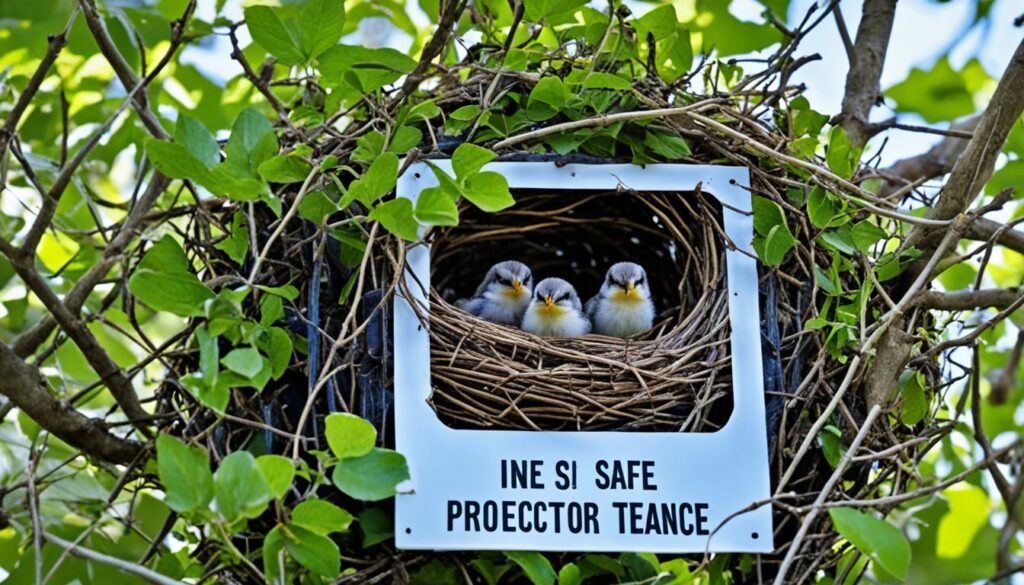
Observing birds the right way helps protect their homes. By knowing what baby birds need, we can keep them safe. Let’s make sure they have a good start to life in their natural homes.
Fascinating Facts About Baby Bird Development
We’ll dive into the captivating world of baby bird development. We’ll find fascinating insights as we journey from delicate hatchlings to graceful fledglings. Each stage is filled with remarkable transformations and adaptations. This is an exploration of how baby birds grow and mature.
The incubation period for baby birds varies a lot, depending on the species. Hummingbird chicks can hatch in only 12-14 days while bald eagle eaglets might take as long as 35 days. This wide range in incubation times shows how different bird species adapt.
Baby bird development introduces the concept of altricial and precocial young. Altricial hatchlings, like nestlings, are born needing care to survive. Precocial chicks of species such as geese and chickens can move and feed themselves right after hatching. This difference in hatchling types shows how unique challenges shape bird species’ lives.
| Baby Bird Type | Incubation Period (Days) | Developmental Stage |
|---|---|---|
| Hummingbird | 12-14 | Altricial |
| Bald Eagle | 35 | Altricial |
| Goose | 28-30 | Precocial |
| Chicken | 21 | Precocial |
As baby birds change from hatchlings to fledglings, they transform physically and behaviorally. At first, nestlings are entirely reliant on their parents. But they soon learn to regulate their body temperature and take their first steps outside the nest.
“The sight of a baby bird taking its first flight is a true wonder of nature, a testament to the resilience and adaptability of these remarkable creatures.”
Baby birds’ growth and development can be impacted by things like food, predators, and even human action. Discovering these details helps us see the balance in bird ecosystems. It also highlights the value of responsible bird watching and conservation work.
Learning about baby bird development deepens our admiration for the journey from hatching to flight. It fulfills our curiosity and motivates us to protect the natural world. This wisdom encourages us to be better caretakers of our environment.
Conclusion
This article has explored the various stages of a baby bird’s life in detail. We started from when they’re freshly out of the egg, called hatchlings. Then we moved all the way to the point where they can fly on their own, known as fledglings. This journey has given us a richer view of the bird world.
Learning the special terms like nestlings and chicks has its benefits. It helps us know what to look for when watching birds. Also, it teaches us how to do it in a gentle way that helps keep them and their homes safe.
The numbers and facts we looked at, like how many survive and how parents feed them, show a lot about baby bird life. All these details highlight why we must take care of the places where these young birds grow. It’s all about respecting and looking after the nature around us.
FAQ
What is a group of baby birds called?
A group of baby birds has different names based on how old they are. Some baby bird terms are hatchlings for newborns, nestlings for those still in nests, and fledglings for ones learning to fly.
What are the different stages of a baby bird’s development?
When talking about baby birds, we have hatchlings, then nestlings, and finally fledglings. Hatchlings are just born, looking fragile with no feathers and closed eyes. Nestlings are in their nests, waiting to grow their wings and start their lives learning from their parents. Last are fledglings, these young ones have feathers and are starting to explore on their own.
What are some specific names for different baby bird species?
There are some really cute names for baby birds. We all know ducklings, but there are also eaglets, bobbies (baby Bobwhites), and just chicks for many others. Occasionally, you find unusual names like “blush duckie” and “off-white” for particular bird babies.
What is the difference between altricial and precocial baby birds?
The types of care baby birds need can be quite different. Altricial babies are helpless at first, needing their parents a lot. On the other hand, precocial babies are more independent from the start. They’re covered with down and can walk or feed themselves right away.
How can I responsibly observe and identify baby birds?
To observe baby birds, knowing their development and behavior is key. This ensures we don’t disturb them. Respect for baby birds’ well-being aids in their survival and growth. Recognizing a bird species by looking closely at young birds helps, even if they don’t look like adults.

